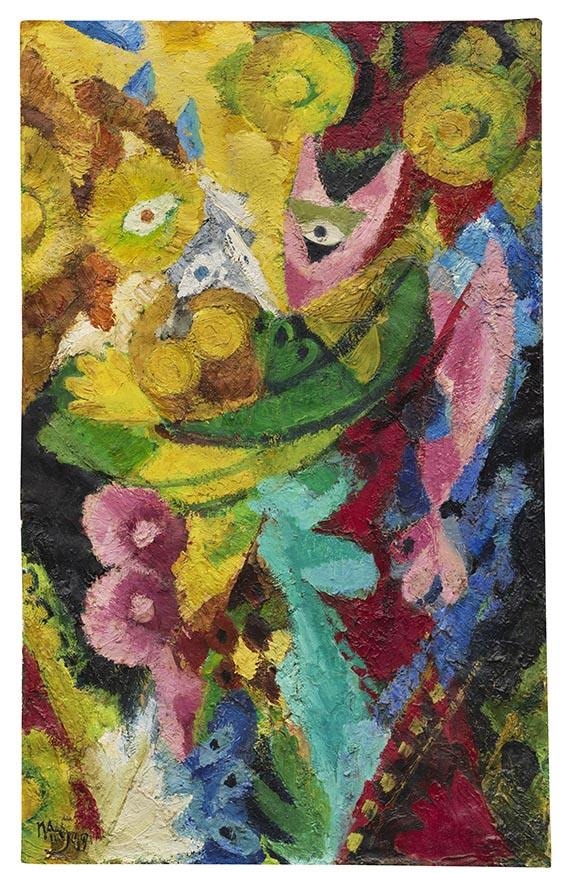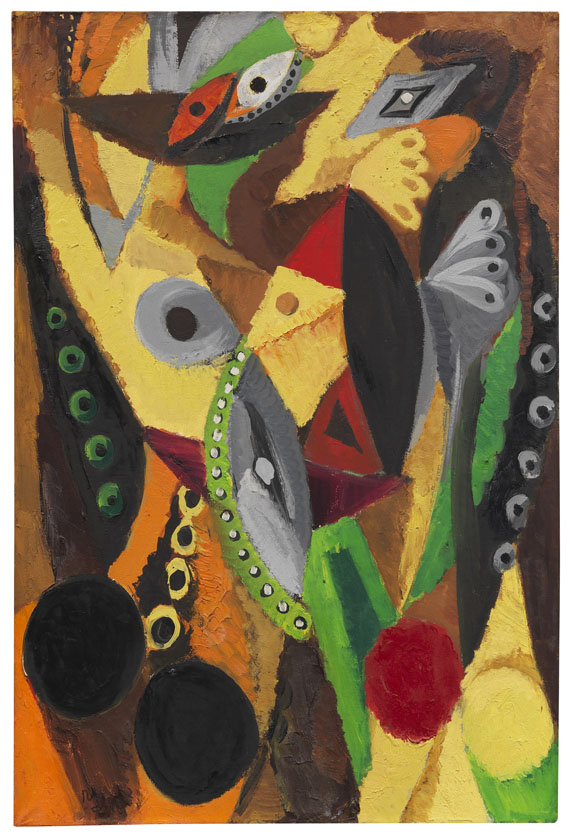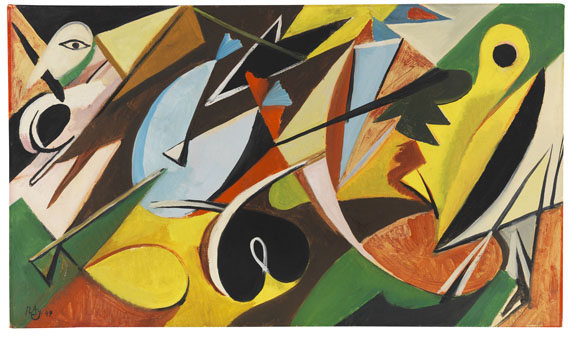124000127
Ernst Wilhelm Nay
Oberon II, 1947.
Olio su tela
Stima: € 100,000 / $ 107,000
Le informationi sulla commissione, le tasse e il diritto di seguito saranno disponibili quattro settimane prima dell´asta.
Oberon II. 1947.
Oil on canvas.
Lower left signed and dated. Inscribed "Nay 'Oberon II' 1947" on the reverse. 100 x 60 cm (39.3 x 23.6 in).
[AR].
•- In "Oberon II", Nay shows his commitment to the power of colors.
• As early as 1948, Baron Döry raved about the work's "glorious colors", the luminous "blaze of color, the like of which there is none".
• From the important series of "Hekate Pictures" that mark the transition from figuration to abstraction.
• Titled after the fairy king from Shakespeare's 'A Midsummer Night's Dream' who is entangled in amorous escapades.
• Impressive exhibition history: shown during his lifetime and posthumously in the artist's most important retrospective exhibitions.
PROVENANCE: Galerie Dr. Werner Rusche, Cologne.
Dr. Hanns Hülsberg Collection, Hagen.
Ever since family-owned.
EXHIBITION: Ernst Wilhelm Nay. Bilder des Jahres 1947, Galerie Dr. Werner Rusche, Cologne, Feb.-March 1948, cat. no. 8 (illu.).
E. W. Nay. Retrospektive, Kunstverein für die Rheinlande und Westfalen, Düsseldorf, January 9 - February 15, 1959, cat. no. 56 (with the label on the reverse).
E. W. Nay. Retrospektive, Württembergischer Kunstverein, Stuttgart, November 12 - December 25, 1966 (with a label on the reverse), Akademie der Künste, Berlin, January 13 - February 12, 1967, Städtische Kunsthalle, Mannheim, March 4 - April 16, 1967 (with a label on the reverse), cat. no. 27.
E. W. Nay. Retrospektive, Museum des 20. Jahrhunderts, Vienna, April 15 - May 15, 1967, cat. no. 26 (with a label on the reverse).
E. W. Nay. Retrospektive, Wallraf-Richartz-Museum, Cologne, April 18 - June 18, 1969, Neue Nationalgalerie, Berlin, June 20 - July 28, 1969, Städelsches Kulturinstitut, Frankfurt a. Main, August 8 - September 21, 1969, Kunstverein Hamburg, October 4 - November 16, 1969, cat. no. 50.
Ernst Wilhelm Nay Retrospektive, Museum Ludwig in der Josef-Haubrich-Kunsthalle, Köln, November 17, 1990 - January 20, 1991, Kunsthalle Basel, March 28 - May 20, 1991, Scottish National Gallery of Modern Art, Edinburgh, June 8 - July 21, 1991 (with a label on the reverse), cat. no. 36 (color illu. on pp. 58).
Ernst Wilhelm Nay. Die Hofheimer Jahre 1945-1951, Städtische Galerie im Städel, Frankfurt a. Main, February 24 - May 23, 1994, Museum der bildenden Künste, Leipzig, June 9 - August 21, 1994, cat. no. 29 (color illu. on p. 52).
Nay - Variationen. Retrospektive zum 100. Geburtstag, Kunsthalle der Hypo-Kulturstiftung, Munich, September 27 - November 24, 2002, Kunstmuseum Bonn, December 19, 2002 - February 16, 2003, cat. no. B 47 (color illu. on p. 119).
LITERATURE: Aurel Scheibler, Siegfried Gohr, Ernst Wilhelm Nay. Catalogue raisonné of oil paintings, vol. 1: 1922-1951, Cologne 1990, no. 385 (color illu.).
Eva Maria Demisch, Die Wandlung des Ernst Wilhelm Nay. Zum Tod eines Malers, der ein Rhapsode der Farben war, in: Frankfurter Allgemeine Zeitung, no. 86, April 10, 1968, p. 24.
Sabine Schultze, Nay – Nachlese. Zur Gedächtnisausstellung im Frankfurter Städel, in: Der Kunsthandel, vol. 61, issue 9, Heidelberg 1969, p. 25.
Werner Haftmann, E. W. Nay, Cologne 1991 (extended new edition), pp. 133f, p. 137.
Ludwig Baron Döry, Begegnungen mit Nay, in: Klaus Gallwitz (ed.), Ernst Wilhelm Nay. Die Hofheimer Jahre 1945–51, Frankfurt a. M. 1994, pp. 141-157, here pp. 143f.
Elisabeth Nay-Scheibler, Die Titel der Hekate-Bilder, in: Klaus Gallwitz (ed.), Ernst Wilhelm Nay. Die Hofheimer Jahre 1945–51, Frankfurt a. M. 1994, pp. 69–75, here p. 74 (color illu. p. 52).
A. Thormüller, Die Mythen sind greifbar, in: Frankfurter Allgemeine Zeitung, no. 48, February 26, 1994, p. 29.
Magdalene Claesges, Das Elementare Bild. Zur Genese und Charakteristik des Spätwerks von Nay, in: Nay – Variationen. Retrospektive zum 100. Geburtstag. Ex. cat. Kunsthalle der Hypo-Kulturstiftung, Munich/ Kunstmuseum, Bonn. Cologne 2002, pp. 23–30, here p. 23.
Guido Reuter, Am Scheideweg der Hekate: die Hekate-Bilder Ernst Wilhelm Nays und die Diskussion um die abstrakte Malerei nach 1945 in Deutschland, in: Düsseldorfer Kunsthistorische Schriften, Düsseldorf 2002, p. 55.
Christoph Schreier, Auf der Suche nach dem Essentiellen. Gedanken zur Werkentwicklung bei Nay, in: Siegfried Gohr, et al (ed.), Nay – Variationen, Cologne 2002, p. 19.
Friedrich Weltzien, E. W. Nay – Figur und Körperbild. Kunst und Kunsttheorie der vierziger Jahre, Berlin 2003, pp. 107, 200, 237, 243, 326 (illu. no. 79).
Karin Schick, Kontakt. Zur Bedeutung von Sprache bei Ernst Wilhelm Nay, in: Karin Schick, Sophia Colditz, Roman Zieglgänsberger (ed.), E. W. Nay. Retrospektive, Cologne 2022, pp. 16-27, here p. 18.
"What is so astonishingly new to me about Nay's paintings today? The magnificent colors!..now they glow, in a blaze of colors that is unparalleled. Namely Oberon II, Paolo und Francesca II, Gärtnerin.."
Ludwig Baron Döry in a diary entry from March 9, 1948.
Flower of this purple dye
Hit with Cupid's archery,
Sink in apple of his eye.
When his love he doth espy,
Let her shine as gloriously
As the Venus of the sky.
When thou wakest, if she be by,
Beg of her for remedy.
Elf king Oberon in William Shakespear's 'A Midsummer Night's Dream', 3rd act.
Oil on canvas.
Lower left signed and dated. Inscribed "Nay 'Oberon II' 1947" on the reverse. 100 x 60 cm (39.3 x 23.6 in).
[AR].
•- In "Oberon II", Nay shows his commitment to the power of colors.
• As early as 1948, Baron Döry raved about the work's "glorious colors", the luminous "blaze of color, the like of which there is none".
• From the important series of "Hekate Pictures" that mark the transition from figuration to abstraction.
• Titled after the fairy king from Shakespeare's 'A Midsummer Night's Dream' who is entangled in amorous escapades.
• Impressive exhibition history: shown during his lifetime and posthumously in the artist's most important retrospective exhibitions.
PROVENANCE: Galerie Dr. Werner Rusche, Cologne.
Dr. Hanns Hülsberg Collection, Hagen.
Ever since family-owned.
EXHIBITION: Ernst Wilhelm Nay. Bilder des Jahres 1947, Galerie Dr. Werner Rusche, Cologne, Feb.-March 1948, cat. no. 8 (illu.).
E. W. Nay. Retrospektive, Kunstverein für die Rheinlande und Westfalen, Düsseldorf, January 9 - February 15, 1959, cat. no. 56 (with the label on the reverse).
E. W. Nay. Retrospektive, Württembergischer Kunstverein, Stuttgart, November 12 - December 25, 1966 (with a label on the reverse), Akademie der Künste, Berlin, January 13 - February 12, 1967, Städtische Kunsthalle, Mannheim, March 4 - April 16, 1967 (with a label on the reverse), cat. no. 27.
E. W. Nay. Retrospektive, Museum des 20. Jahrhunderts, Vienna, April 15 - May 15, 1967, cat. no. 26 (with a label on the reverse).
E. W. Nay. Retrospektive, Wallraf-Richartz-Museum, Cologne, April 18 - June 18, 1969, Neue Nationalgalerie, Berlin, June 20 - July 28, 1969, Städelsches Kulturinstitut, Frankfurt a. Main, August 8 - September 21, 1969, Kunstverein Hamburg, October 4 - November 16, 1969, cat. no. 50.
Ernst Wilhelm Nay Retrospektive, Museum Ludwig in der Josef-Haubrich-Kunsthalle, Köln, November 17, 1990 - January 20, 1991, Kunsthalle Basel, March 28 - May 20, 1991, Scottish National Gallery of Modern Art, Edinburgh, June 8 - July 21, 1991 (with a label on the reverse), cat. no. 36 (color illu. on pp. 58).
Ernst Wilhelm Nay. Die Hofheimer Jahre 1945-1951, Städtische Galerie im Städel, Frankfurt a. Main, February 24 - May 23, 1994, Museum der bildenden Künste, Leipzig, June 9 - August 21, 1994, cat. no. 29 (color illu. on p. 52).
Nay - Variationen. Retrospektive zum 100. Geburtstag, Kunsthalle der Hypo-Kulturstiftung, Munich, September 27 - November 24, 2002, Kunstmuseum Bonn, December 19, 2002 - February 16, 2003, cat. no. B 47 (color illu. on p. 119).
LITERATURE: Aurel Scheibler, Siegfried Gohr, Ernst Wilhelm Nay. Catalogue raisonné of oil paintings, vol. 1: 1922-1951, Cologne 1990, no. 385 (color illu.).
Eva Maria Demisch, Die Wandlung des Ernst Wilhelm Nay. Zum Tod eines Malers, der ein Rhapsode der Farben war, in: Frankfurter Allgemeine Zeitung, no. 86, April 10, 1968, p. 24.
Sabine Schultze, Nay – Nachlese. Zur Gedächtnisausstellung im Frankfurter Städel, in: Der Kunsthandel, vol. 61, issue 9, Heidelberg 1969, p. 25.
Werner Haftmann, E. W. Nay, Cologne 1991 (extended new edition), pp. 133f, p. 137.
Ludwig Baron Döry, Begegnungen mit Nay, in: Klaus Gallwitz (ed.), Ernst Wilhelm Nay. Die Hofheimer Jahre 1945–51, Frankfurt a. M. 1994, pp. 141-157, here pp. 143f.
Elisabeth Nay-Scheibler, Die Titel der Hekate-Bilder, in: Klaus Gallwitz (ed.), Ernst Wilhelm Nay. Die Hofheimer Jahre 1945–51, Frankfurt a. M. 1994, pp. 69–75, here p. 74 (color illu. p. 52).
A. Thormüller, Die Mythen sind greifbar, in: Frankfurter Allgemeine Zeitung, no. 48, February 26, 1994, p. 29.
Magdalene Claesges, Das Elementare Bild. Zur Genese und Charakteristik des Spätwerks von Nay, in: Nay – Variationen. Retrospektive zum 100. Geburtstag. Ex. cat. Kunsthalle der Hypo-Kulturstiftung, Munich/ Kunstmuseum, Bonn. Cologne 2002, pp. 23–30, here p. 23.
Guido Reuter, Am Scheideweg der Hekate: die Hekate-Bilder Ernst Wilhelm Nays und die Diskussion um die abstrakte Malerei nach 1945 in Deutschland, in: Düsseldorfer Kunsthistorische Schriften, Düsseldorf 2002, p. 55.
Christoph Schreier, Auf der Suche nach dem Essentiellen. Gedanken zur Werkentwicklung bei Nay, in: Siegfried Gohr, et al (ed.), Nay – Variationen, Cologne 2002, p. 19.
Friedrich Weltzien, E. W. Nay – Figur und Körperbild. Kunst und Kunsttheorie der vierziger Jahre, Berlin 2003, pp. 107, 200, 237, 243, 326 (illu. no. 79).
Karin Schick, Kontakt. Zur Bedeutung von Sprache bei Ernst Wilhelm Nay, in: Karin Schick, Sophia Colditz, Roman Zieglgänsberger (ed.), E. W. Nay. Retrospektive, Cologne 2022, pp. 16-27, here p. 18.
"What is so astonishingly new to me about Nay's paintings today? The magnificent colors!..now they glow, in a blaze of colors that is unparalleled. Namely Oberon II, Paolo und Francesca II, Gärtnerin.."
Ludwig Baron Döry in a diary entry from March 9, 1948.
Flower of this purple dye
Hit with Cupid's archery,
Sink in apple of his eye.
When his love he doth espy,
Let her shine as gloriously
As the Venus of the sky.
When thou wakest, if she be by,
Beg of her for remedy.
Elf king Oberon in William Shakespear's 'A Midsummer Night's Dream', 3rd act.
Surprisingly often, parallels to his biography and historical events can be seen in Ernst Wilhelm Nay's artistic developments. Inspired by a stay in Norway and the light of the north, he found his way to the pure expressive power of color at an early stage in his so-called "Lofoten Paintings" (1937-38). His "Rhythmic Paintings" (1952-53), which are characterized by the spirit of optimism of the post-war period in Cologne, marked the beginning of his abstract work almost two decades later.
"Oberon II" was created in the period between these two groups of works, shortly after the end of the Second World War and the artist's return from military service in France. Nay was living in Hofheim im Taunus at the time. The painter and collector Hanna Bekker vom Rath, who had already made an important contribution to the promotion of modern art during the war, helped him find accommodation there after his Berlin studio had been destroyed in the war. Nay would stay in the tranquil little town until 1951, before he moved to the lively city of Cologne. They span the years from 1945-48 and stylistically represent the important transition from figuration to abstraction. Ernst Gosebruch, a long-time friend of the artist and director of the Folkwang Museum in Essen, only gave them their name some time later. He took the name by chance from the work "Tochter der Hekate" when he inquired about the paintings from Hofheim. As their titles suggest, the works were embedded in mythological, religious and literary themes. But they are not depictions of historical models, but refer to a "deeper origin" of the works, as Elisabeth Nay-Scheibler describes it, "which is concealed behind their beauty" (Aurel Scheibler, Siegfried Gohr, Ernst Wilhelm Nay. Catalogue raisonné of oil paintings, vol. 1: 1922-1951, Cologne 1990, p. 224). She goes on to write that Ernst Wilhelm Nay used them to come to terms with his war experiences and at the same time dared to look forward to a post-war period full of hope that seemed to be on the horizon.
In this context, "Oberon II" is one of the most positive works among the "Hekate Paintings". The color palette in luminous pastel tones inspired his art historian friend Ludwig Baron Döry just one year after its creation. In a diary entry, he noted: "What is so astonishingly new to me about Nay's paintings today? The magnificent colors!..now they glow, in a blaze of colors that is unparalleled. Namely Oberon II, Paolo und Francesca II, Gärtnerin.." (Ludwig Baron Döry, diary entry from March 9, 1948, for the source cf. literature). The work from 1947 is titled after Oberon, the elf king from Shakespeare's 'A Midsummer Night's Dream', who is entangled in love affairs. As is so often the case with Nay's works, the title invites the viewer to look for signs of the English poet's comedy in the half-figurative, half-abstract composition. Eyes can be recognized, light pink body parts, sun-yellow circular shapes, green and blue plants can be identified.
Yet they do not form a coherent narrative thread, refusing a clear interpretation in their composition, which is divided into cold and warm color values. Nay's path to pure abstraction, which his work would take in the following years until the end of his life, is unmistakably foreshadowed here. His formal vocabulary of circles, spindles and hands, which would recur in later groups of works, is already visibly incorporated in the "Hekate Pictures". However, the deeper origins of his works and the literary, narrative mood are still balanced in "Oberon II". Nay's subtly balanced "Hekate Pictures" fascinate us to this day with their balance between representationalism, literary references and unreal forms and colors. It is not without reason that "Oberon II" was exhibited in the artist's most important retrospectives for decades, both during his lifetime and posthumously. [AR]
"Oberon II" was created in the period between these two groups of works, shortly after the end of the Second World War and the artist's return from military service in France. Nay was living in Hofheim im Taunus at the time. The painter and collector Hanna Bekker vom Rath, who had already made an important contribution to the promotion of modern art during the war, helped him find accommodation there after his Berlin studio had been destroyed in the war. Nay would stay in the tranquil little town until 1951, before he moved to the lively city of Cologne. They span the years from 1945-48 and stylistically represent the important transition from figuration to abstraction. Ernst Gosebruch, a long-time friend of the artist and director of the Folkwang Museum in Essen, only gave them their name some time later. He took the name by chance from the work "Tochter der Hekate" when he inquired about the paintings from Hofheim. As their titles suggest, the works were embedded in mythological, religious and literary themes. But they are not depictions of historical models, but refer to a "deeper origin" of the works, as Elisabeth Nay-Scheibler describes it, "which is concealed behind their beauty" (Aurel Scheibler, Siegfried Gohr, Ernst Wilhelm Nay. Catalogue raisonné of oil paintings, vol. 1: 1922-1951, Cologne 1990, p. 224). She goes on to write that Ernst Wilhelm Nay used them to come to terms with his war experiences and at the same time dared to look forward to a post-war period full of hope that seemed to be on the horizon.
In this context, "Oberon II" is one of the most positive works among the "Hekate Paintings". The color palette in luminous pastel tones inspired his art historian friend Ludwig Baron Döry just one year after its creation. In a diary entry, he noted: "What is so astonishingly new to me about Nay's paintings today? The magnificent colors!..now they glow, in a blaze of colors that is unparalleled. Namely Oberon II, Paolo und Francesca II, Gärtnerin.." (Ludwig Baron Döry, diary entry from March 9, 1948, for the source cf. literature). The work from 1947 is titled after Oberon, the elf king from Shakespeare's 'A Midsummer Night's Dream', who is entangled in love affairs. As is so often the case with Nay's works, the title invites the viewer to look for signs of the English poet's comedy in the half-figurative, half-abstract composition. Eyes can be recognized, light pink body parts, sun-yellow circular shapes, green and blue plants can be identified.
Yet they do not form a coherent narrative thread, refusing a clear interpretation in their composition, which is divided into cold and warm color values. Nay's path to pure abstraction, which his work would take in the following years until the end of his life, is unmistakably foreshadowed here. His formal vocabulary of circles, spindles and hands, which would recur in later groups of works, is already visibly incorporated in the "Hekate Pictures". However, the deeper origins of his works and the literary, narrative mood are still balanced in "Oberon II". Nay's subtly balanced "Hekate Pictures" fascinate us to this day with their balance between representationalism, literary references and unreal forms and colors. It is not without reason that "Oberon II" was exhibited in the artist's most important retrospectives for decades, both during his lifetime and posthumously. [AR]
124000127
Ernst Wilhelm Nay
Oberon II, 1947.
Olio su tela
Stima: € 100,000 / $ 107,000
Le informationi sulla commissione, le tasse e il diritto di seguito saranno disponibili quattro settimane prima dell´asta.




 Lot 124000127
Lot 124000127 


